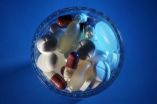(Press-News.org) High blood pressure is highly age-related and affects more than 1 billion people worldwide. But doctors can't fully explain the cause of 90 per cent of all cases. A computer model of a "virtual human" suggests that stiff arteries alone are enough to cause high blood pressure.
"Our results suggest that arterial stiffness represents a major therapeutic target. This is contrary to existing models, which typically explain high blood pressure in terms of defective kidney function," says Klas Pettersen, a researcher at the Norwegian University of Life Sciences and first author of the study, recently published in PLOS Computational Biology.
High blood pressure is a major source of morbidity and mortality, because it makes individuals more prone to heart failure, stroke and kidney disease.
When blood pressure travels down the aorta from the heart, a special group of cells in the aortic wall, called baroreceptors, sense the pressure in this stretch of the aortic wall and send signals with this information to the nervous system.
If the blood pressure is too high, these cells send stronger signals and the body is able to lower blood pressure. However, if the aorta gets stiffer, as typically happens with age, this stretch of the aorta is not as sensitive as it once was in measuring blood pressure. Thus, although a person's blood pressure may have increased, the baroreceptors do not signal as intensively as they should and the body does not get the message to lower blood pressure.
"With the stiffening of the wall that follows ageing, these sensors become less able to send signals that reflect the actual blood pressure. Our mathematical model predicts the quantitative effects of this process on blood pressure," says Pettersen.
"If our hypothesis is proven right, arterial stiffness and baroreceptor signaling will become hotspot targets for the treatment of high blood pressure and the development of new medicines and medical devices," says Stig W. Omholt from the Norwegian University of Science and Technology, who was the senior investigator of the research project.
With the use of existing experimental data and models of the aging human aorta, the researchers were able to show quantitatively how the stiffening of the aorta with age causes the baroreceptors to misinform the central nervous system about blood pressure, thus preventing the system from downregulating blood pressure. The model predictions were compared with data from the Nord-Trøndelag Health Study (HUNT2), which is comprised of information on the health history of 74,000 people, including blood sample collection from 65,000 people.
NTNU's Omholt says that the study is a good example of how very complex human disease can be understood by use of mathematical models and thus allow for much better treatment strategies.
"If we are to succeed in developing predictive, preventive and participatory medicine envisioned by so many, there is no substitute for building much stronger transdisciplinary ties between the life sciences, the mathematical sciences and engineering across the whole spectrum of basic, translational and applied research. And mathematical models of the human physiology will be at the core of this development," he says.
INFORMATION:
In September the Norwegian University of Science and Technology will host the biannual conference on the Virtual Physiological Human, where this research will be presented. http://www.ntnu.edu/vph2014
Reference: http://www.ploscompbiol.org/article/info%3Adoi%2F10.1371%2Fjournal.pcbi.1003634
'Virtual human' shows that stiff arteries can explain the cause of high blood pressure
Norwegian researchers use large database and computer model to understand high blood pressure
2014-05-27
ELSE PRESS RELEASES FROM THIS DATE:
Why does bacon smell so good? (video)
2014-05-27
WASHINGTON, May 27, 2014 — We all know bacon is delicious, but what is it about cooking bacon that makes it smell so tantalizing? In the American Chemical Society's (ACS') latest Reactions video, the team puts its nose into everyone's favorite breakfast food. We collaborated with the Compound Interest blog to break down the science of that sweet smell. The video is available at http://youtu.be/2P_0HGRWgXw
Subscribe to the series at Reactions YouTube, and follow us on Twitter @ACSreactions to be the first to see our latest videos.
INFORMATION:
The American Chemical ...
Scientists map the worst times of day for people allergic to grass pollen
2014-05-27
Atishoo! Help, there are flowering grasses around, please stay indoors – while your friends enjoy the nice summer weather! Traditionally, people allergic to grass pollen are advised to be aware of high pollen concentrations during the day, and to reduce their outdoor activities during this period.
A new study led by researchers from Aarhus University shows that it is considerably more complicated to avoid grass pollen. Based on a three-year study with intensive measurements at three different locations in Aarhus, they divide the grass pollen season into three periods, ...
Sperm cells are extremely efficient at swimming against a current
2014-05-27
Like salmon traveling upstream to spawn, sperm cells are extremely efficient at swimming against the current, according to research to be published this week.
The discovery, to be published in the journal eLife by researchers at MIT and Cambridge University, may help us to understand how some sperm travel such long distances, through difficult terrain, to reach and fertilize an egg.
Of the hundreds of millions of sperm cells that begin the journey up the oviducts, only a few hardy travelers will ever reach their destination. Not only do the cells have to swim in the ...
Attack is not always the best defense
2014-05-27
Jena (Germany) It is something like the police force of our body: the immune system. It disables intruding pathogens, it dismantles injured tissue and boosts wound healing. In this form of 'self-defense' inflammatory reactions play a decisive role. But sometimes the body's defense mechanism gets out of control and cells or tissues are affected: "Then excessive reactions can occur and illnesses along with them," Prof. Dr. Oliver Werz of the Friedrich Schiller University Jena says. He gives asthma, rheumatism, arteriosclerosis and cancer as examples: "For many of these diseases ...
The secret cargo of mosquitoes
2014-05-27
The parasite Dirofilaria repens is a roundworm that primarily attacks the subcutaneous tissue of dogs and causes lumps in the skin, swelling, and itching. Dogs, cats, foxes, wolves and martens can be infected in addition to dogs. "In humans, 16 cases of human dirofilariosis have been recorded since the year 2000, but the dark figure is definitely higher", says the lead author Katja Silbermayr. Humans, however, are so-called dead end hosts; the parasite does not reproduce in humans and therefore poses no major risk.
Silbermayr is a veterinarian and performs research on ...
Seeing e-cigarette use encourages young adult tobacco users to light up
2014-05-27
VIDEO:
"Whether participants were exposed to someone smoking a combustible or an e-cigarette, the urge to smoke a combustible cigarette was just as high in either condition, " King said. "If the...
Click here for more information.
Seeing people use electronic cigarettes (e-cigarettes) increases the urge to smoke among regular combustible cigarettes users, according to a new study of young adult smokers. This elevated desire is as strong as when observing someone ...
Stanford researchers discover immune system's rules of engagement
2014-05-27
A study led by researchers at Stanford's School of Medicine reveals how T cells, the immune system's foot soldiers, respond to an enormous number of potential health threats.
X-ray studies at the Department of Energy's SLAC National Accelerator Laboratory, combined with Stanford biological studies and computational analysis, revealed remarkable similarities in the structure of binding sites, which allow a given T cell to recognize many different invaders that provoke an immune response.
The research demonstrates a faster, more reliable way to identify large numbers ...
Climate change accelerates hybridization between native and invasive species of trout
2014-05-27
BOZEMAN, Mont. – Scientists have discovered that the rapid spread of hybridization between a native species and an invasive species of trout in the wild is strongly linked to changes in climate.
In the study, stream temperature warming over the past several decades and decreases in spring flow over the same time period contributed to the spread of hybridization between native westslope cutthroat trout and introduced rainbow trout – the world's most widely introduced invasive fish species –across the Flathead River system in Montana and British Columbia, Canada.
Experts ...
New perspectives to the design of molecular cages
2014-05-27
Researchers from the University of Jyväskylä report a new method of building molecular cages. The method involves the exploitation of intermolecular steric effects to control the outcome of a self-assembly reaction.
Molecular cages are composed of organic molecules (ligands) which are bound to metal ions during a self-assembly process. Depending on the prevailing conditions, self-assembly processes urge to maximize the symmetry of the system and thus occupy every required metal binding site. The research group led by docent Manu Lahtinen (University of Jyväskylä, Department ...
Molecules do the triple twist
2014-05-27
An international research team led by Academy Professor Kari Rissanen of the University of Jyväskylä (Finland) and Professor Rainer Herges of the University of Kiel (Germany) has managed to make a triple-Möbius annulene, the most twisted fully conjugated molecule to date, as reported in Nature Chemistry (DOI:10.1038/nchem.1955, published online 25 May 2014).
An everyday analogue of a single twisted Möbius molecule is a Möbius strip. It can be made easily by twisting one end of a paper strip by 180 degrees and then joining the two ends. A triple twisted Möbius molecule ...
LAST 30 PRESS RELEASES:
Nanoplastics have diet-dependent impacts on digestive system health
Brain neuron death occurs throughout life and increases with age, a natural human protein drug may halt neuron death in Alzheimer’s disease
SPIE and CLP announce the recipients of the 2025 Advanced Photonics Young Innovator Award
Lessons from the Caldor Fire’s Christmas Valley ‘Miracle’
Ant societies rose by trading individual protection for collective power
Research reveals how ancient viral DNA shapes early embryonic development
A molecular gatekeeper that controls protein synthesis
New ‘cloaking device’ concept to shield sensitive tech from magnetic fields
Researchers show impact of mountain building and climate change on alpine biodiversity
Study models the transition from Neanderthals to modern humans in Europe
University of Phoenix College of Doctoral Studies releases white paper on AI-driven skilling to reduce burnout and restore worker autonomy
AIs fail at the game of visual “telephone”
The levers for a sustainable food system
Potential changes in US homelessness by ending federal support for housing first programs
Vulnerability of large language models to prompt injection when providing medical advice
Researchers develop new system for high-energy-density, long-life, multi-electron transfer bromine-based flow batteries
Ending federal support for housing first programs could increase U.S. homelessness by 5% in one year, new JAMA study finds
New research uncovers molecular ‘safety switch’ shielding cancers from immune attack
Bacteria resisting viral infection can still sink carbon to ocean floor
Younger biological age may increase depression risk in older women during COVID-19
Bharat Innovates 2026 National Basecamp Showcases India’s Most Promising Deep-Tech Ventures
Here’s what determines whether your income level rises or falls
SCIE indexation achievement: Celebrate with Space: Science & Technology
Children’s Hospital Colorado performs region’s first pediatric heart and liver dual organ transplant
Australian team discover why quantum computers have memory problems over time
What determines the fate of a T cell?
Candida auris: genetic process revealed which could be treatment target for deadly fungal disease
Groundbreaking discovery turns household plastic recycling into anti-cancer medication
Blocking a key inflammatory pathway improves liver structure and vascular function in cirrhosis, study finds
Continuous spread: Raccoon roundworm detected in nine European countries
[Press-News.org] 'Virtual human' shows that stiff arteries can explain the cause of high blood pressureNorwegian researchers use large database and computer model to understand high blood pressure






